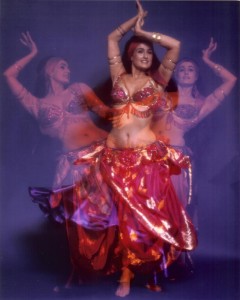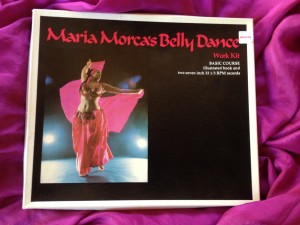
During the ’70s, belly dance books flourished. From how-tos to histories, paperbacks and hardcovers with lots of pictures made it into print and, by the ’90s, onto used bookstores’ shelves.
I stalked these books, lucking into volumes by Serena Wilson and Özel Türkbaş, Sula and others. After practicing or class, I’d look at the photos and wonder when I’d be able to stare into the camera with such confidence.
But it wasn’t until I discovered “Maria Morca’s Belly Dance Work Kit” on a shelf at the Capitol Hill Half-Price Books that I came across these words:
“Did you, when you picked up this kit, realize that you were also picking up a way towards personal identity?”
Not then, but I do now.
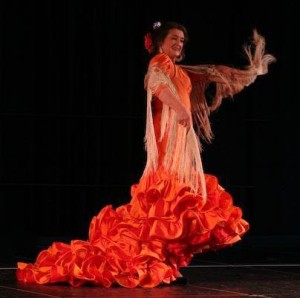 Have you ever wished a character in a book would just come alive and talk with you or teach you what she knows? Yes, it’s that freaking exciting. More than a decade later, I have the privilege of being coached by Maria Morca. Let me tell you about her.
Have you ever wished a character in a book would just come alive and talk with you or teach you what she knows? Yes, it’s that freaking exciting. More than a decade later, I have the privilege of being coached by Maria Morca. Let me tell you about her.
Although she’s from a musical family, a trip to the movies when she was five secured her future. After seeing the dancer moving on the screen, all she wanted to do was dance. 75 years later, Maria is still dancing, teaching flamenco classes for children and adults in Bothell at Zamani World Dance and LaVida Dance and Yoga in Bellevue. She also offers vintage belly dance workshops and coaches belly dancers like me and Belly Dance of the Universe champion Roxy Stimpson.
At eighty, keeping up with Maria Morca can still make me sweat.
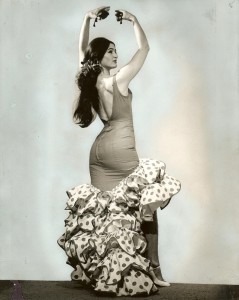
Maria’s professional career began when she went on the road with Lola Montes and Her Spanish Dancers, touring the U.S., Mexico and Canada. Maria celebrated her 21st birthday with the group: “When you’re traveling, you can’t gain weight, so desserts were not a problem. I think I had a strawberry shortcake,” she says.
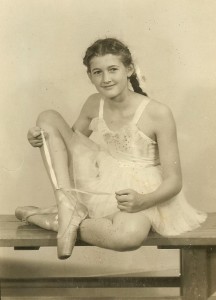
But before hitting the stage, Maria studied ballet and interpretive dance with Karoun Tootikian, a Denishawn dancer and Director of the Ruth St. Denis Foundation. Maria’s studies were interrupted when Tootikian went to work on the Hollywood production of “The King and I” as a consultant to the choreographer.
While she was away, Tootikian asked Maria’s parents to continue her studies in classical ballet with Vaslav Nijinksy‘s sister, Bronislava Nijinska.
When Tootikian returned to teaching, she only wanted to teach at the Foundation, which was very far from Maria’s home. As working musicians, her parents could only afford one class — and Maria had to take three buses and walk one-quarter of a mile on an unpaved street to get there (the street is now Ventura Blvd.).
Through Tootikian, Maria became a protégée of the Ruth St. Denis Foundation. Her parents paid for one class and the Foundation gifted her others, allowing Maria to expand her studies.
One of the founders of modern dance, St. Denis built her reputation traveling the world performing dances inspired by Egypt, India, China and other locations. When asked what it was like to study at the Foundation, Maria tells me:
“Miss Ruth did not teach. You absorbed from her demonstration, from her conversation. Teaching wasn’t one of her fortés, but certainly she is a great influence for anyone who was at the Foundation.”
Decades later, Maria continues to draw on that experience:
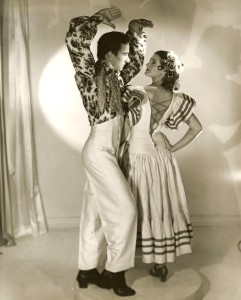
“Miss Ruth would from time to time tell us stories or [demonstrate] ‘how it should be done’ or she would give us little gifts from her travels. One time she opened a big steam trunk and gave something to each one of us. And there was a picture from National Geographic of a Balinese dancer and I wanted that so much. She gave me an old Christmas card of the Madonna and Child. She could see on my face that that wasn’t what I wanted. ‘When you learn to dance and the audience can believe you are actually holding the Christ child in your arms, then you’re an artist.'”
I asked Maria to tell me if she’s pulled it off. Despite a lifetime of achievements, here’s what she had to say:
“Not yet, my career, as everybody else’s, is evolving, which is wonderful because you never feel like you’ve done it all. There’s always something exciting to look forward to.”
Studying at the Foundation was “very magical” Maria says.
“We would never know when Miss Ruth would appear. She lived upstairs. There was always a lot of activity and one of the reasons it was very exciting was because visiting artists from around the world would stay at the Foundation. What do you do when you’re in-between jobs? You teach.”
During that time, Maria learned from dancers from Japan’s Kabuki theater, Tahitian from several large groups including Hilo Hattie, Javanese and Indonesian dance as well as studying with dancers from India.
Transfer of energy
I asked Maria to share one thing she learned from St. Denis that she still uses on stage today. She said it was “very hard” to pick one thing:
“Miss Ruth also was very much into esoterics and flow of energy and one of the things when she would demonstrate was how to flow one move into the other. It flowed something like you might find in aikido for when you do a movement and your movement goes through your partner and flips them.”
In addition, Maria mentioned St. Denis’s skills as a dramatist and ability to project, “But it took many, many years for these early impressions to surface in my work. The older my work and I get, the more I rely on these things.”
[soliloquy id=”244″]
[soliloquy slug="maria-morcas-fabulous-costumes"]
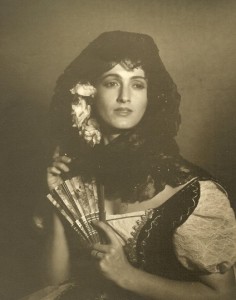
Getting to know her first love: Flamenco
When she was 13, Maria was out front of her school doing “noon duty” with another student of dance. Except her friend was studying flamenco. When the friend’s father learned that Maria was studying with the Ruth St. Denis Foundation, he told his daughter to teach Maria what she was learning and wanted Maria to share what she knew. After that, Maria says, “I was hooked.”
“There is a certain type of nostalgia that flamenco music has within it and it’s kind of like you’re drawn to return to something so nostalgic that it’s probably so far back in your past or maybe even before that, who knows, but it’s a longing to get to back to your soul.”
Becoming a belly dancer
Six years later, Maria made her living dancing flamenco and continued to do so until the ’60s when belly dance superseded flamenco in popularity.
By this time, Maria had also made inroads into Hollywood’s studios, accepting calls whenever they needed an ethnic dancer. She met Zanouba of Cairo after watching her bead a costume while on the set. Taught to bead by her grandmother, Maria recognized the complexity of the woman’s work. After asking if she was a “belly dancer,” Maria learned that the woman called herself an “oriental dancer,” but she also invited her to one of her shows.
But it wasn’t until one hot day that belly dance became a possibility. As the Santa Ana winds blew heat into Los Angeles, rendering Maria’s small apartment unbearable, her friend, Zanouba, invited her to swim at her apartment’s pool. The high-end address caught Maria’s attention. As a consequence of the swim, she moved into a nearby apartment at a reduced rate.
That New Year’s Zanouba called her with a paying gig that required two other dancers. She wanted Maria and Aisha Ali to perform. But Maria was worried that she didn’t know how to belly dance.
“Don’t worry you’re a professional dancer, I teach you five steps. You just do it over and over.”
Maria made a costume and danced. As the night wore on, the party got rowdier and one of the guests wrapped an ice cube in a dollar bill and put it down her bra.
After giving him a karate chop, Maria thought she’d never belly dance again, but she’d been working in movies and TV and had let casting know that she had a belly dance costume. A short while later, they called her for “I Dream of Jeannie.” Maria’s dancing in purple in the remixed clip below, followed by Zanouba of Cairo.
At that time, she averaged two or three shows a week, racking up credits like:
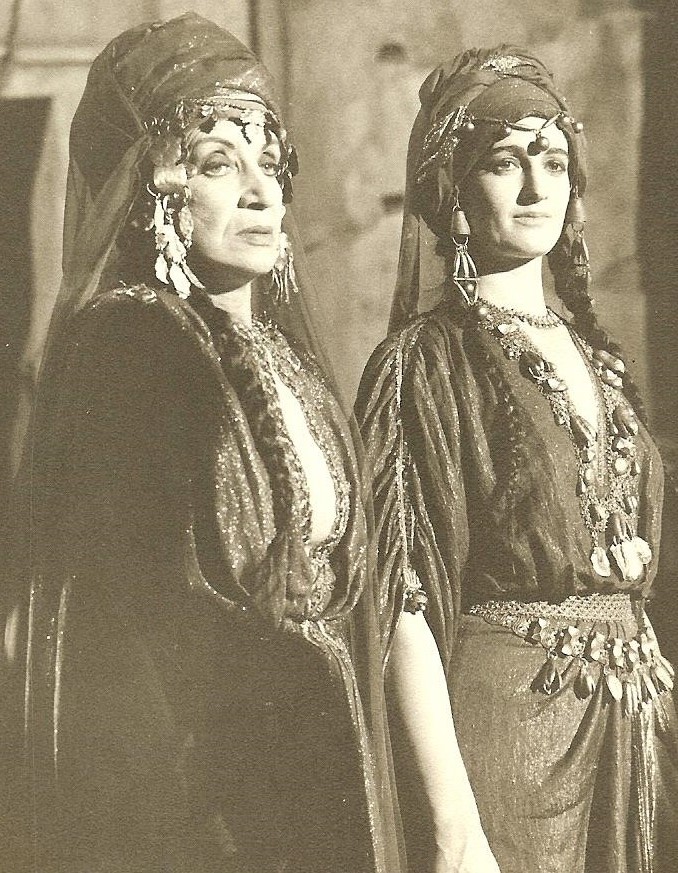
The Brother’s Grimm
Ship of Fools
I Dream of Jeannie
Gunsmoke
Mission Impossible TV show
I Spy
The Greatest Story Ever Told
(at left, Maria is on the right)
The Story of Ruth
The Lucy Show
Can Can
Hello Dolly
Funny Girl
The Nutty Professor
Two Weeks in Another Town
Unsinkable Molly Brown
Run For Your Life
Journey to the Center
of the Earth
Plus various television commercials
Toronto connection
In the ’70s belly dance as a fun way to get and stay fit was heading north, Maria relocated to Toronto, Canada. At the time, Maria was teaching, but only had a few students in flamenco and an equal number in belly dance until a local paper asked her to “mentor” an article on belly dance. She was supposed to help the model look authentic during the photo shoot.
She arrived at the shoot with four costumes. The model never showed because at the dance store she could only find a white leotard in her size. Concerned that it would be too see-through, she cancelled.
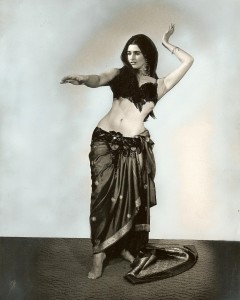 The newspaper turned to Maria. She ended up with a three-page write-up that included her phone number. Soon she was teaching four nights a week, three times a night with 12 students in each class.
The newspaper turned to Maria. She ended up with a three-page write-up that included her phone number. Soon she was teaching four nights a week, three times a night with 12 students in each class.
Maria connected with George Sawa, who was a student at the University of Toronto and a “brilliant” qanun player. He and his ensemble would play jobs for Maria and her students and she invited him to collaborate on the LPs that went into her work kit. Sawa is now an ethnomusicologist who continues to play and teach in Canada.
For a long while, Maria was the only belly dance instructor in Toronto. Given belly dancing’s challenging reputation and Maria’s understanding of dance history, she began formulating her ideas and wrote several articles for dance magazines.
Around the same time, Penguin Books reached out to her and suggested she write a book on belly dance.
“My whole mission was that belly dancing can be a performing art and the history of why it has such a tarnished reputation, but Penguin Books wanted a book with lots of how to and photos of dancers in skimpy costumes. Exactly the opposite of what I wanted to say.”
When Maria explained her position, Penguin withdrew it’s offer. She says she would have been happy to write a pamphlet for her students, but her husband at the time encouraged her to go ahead with the book. Although the book is currently out of print, she has a limited number of copies available.
Some years later, Maria returned to her “first love” to form “Maria Morca’s Dances of Spain,” creating many choreographies which continue to be performed around the Pacific Northwest. She also created “Maria Morca and the Middle Eastern Ensemble,” appearing at events around the Seattle-area.
Maria passed her dance companies to her gifted students Jacquelina Villegas-MacLin and Deborah Katz, thinking she would enjoy the weather, she went back California several years ago. Finding it too hot, she’s back teaching and performing in the Seattle area.
Villegas-MacLin still produces and teaches flamenco in the Seattle area while Katz passed on Maria’s Middle Eastern Ensemble to Bellevue’s Zulaika after only a few months.
Dance continues to be a form a self-expression for Maria. She also credits dance with maintaining her mental and physical vitality: “The more flexible you are physically, the more flexible you are in life.”
Accepting students
Maria Morca is currently accepting students in both flamenco and belly dance. Reach her at mariamorca@sbcglobal.net.
Upcoming performance
Springtide at Third Place Books
May 2nd, 1-4pm
(other dancers will also be performing)
Practical advice
Visualization: Maria tells me she’s never liked to practice, but while riding all those buses to get to the Ruth St. Denis Foundation, she developed the ability to mentally practice to the music she could hear in her head. “Most of my planning out of a program or setting a choreography or even teaching a class is done to this day in a nonphysical mode and then is tried with physical movement,” she says.
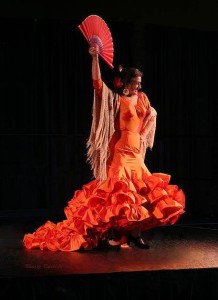
Posture: A session with Maria makes me sit and stand taller for a number of days. One of the most noticeable things about her is her posture, which would be extraordinary on a twenty-year-old and is impressive for someone who’s turned eighty this past January. I asked her what advice she might have for chronic slouchers: “Remember that flamenco dictates a certain upright posture. Notice I said upright, not uptight.” Maria credits many of her postural habits with being born into a family of professional musicians and dancers, but says “one of the benefits of dance is that it improves your posture, “making it easier to breathe as you take weight off your abdominals, which is especially important for women. With proper carriage, you are more flexible and you can move more freely.” Standing and sitting correctly, Maria says, alleviates a great deal of pain “and it’s better than taking aspirin.”
Know of a belly dancer who needs her (or his) story told? Once a month, I’m blogging about dancers from the 1970s (and earlier) with the goal of educating and expanding audience for this incredible dance form. The selection process is entirely subjective. Please send suggestions to jcobrienbooks@gmail.com.
